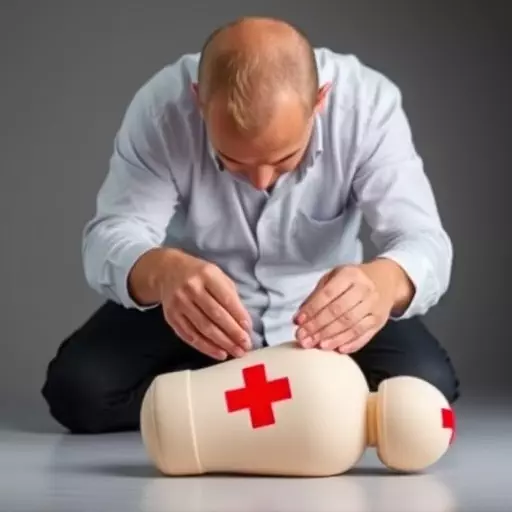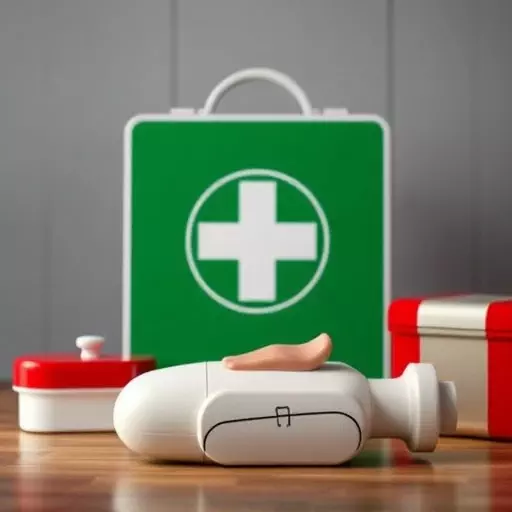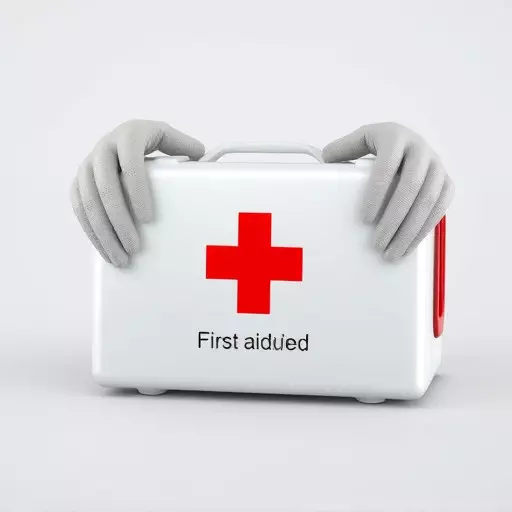TL;DR:
Understanding and acquiring Basic Life Support (BLS) and CPR training is crucial for handling life-threatening emergencies. BLS involves immediate actions like recognizing cardiac arrest until professional help arrives. First aid and CPR training teaches essential techniques such as assessment, rescue breathing, and chest compressions at the correct ratio. Mastering proper compression techniques, including depth, rate, and technique, significantly impacts survival rates during cardiac emergencies.
This section provides a comprehensive guide on performing chest compressions, detailing step-by-step instructions for positioning, grip, compression depth, speed, and rescue breath ratio. It emphasizes continuous compressions for successful CPR. BLS training meets first aid certification requirements, empowering individuals to handle emergencies effectively until professional help arrives.
Additional vital skills include combining CPR with AED usage, which significantly improves survival rates. Avoiding common mistakes, such as neglecting safety checks or improper chest compression techniques, is critical. Obtaining training from accredited institutions ensures participants can swiftly respond to emergency situations and meet specific first aid certification requirements by region.
In the event of a cardiac emergency, Basic Life Support (BLS) and Cardiopulmonary Resuscitation (CPR) can be lifesaving skills. Understanding the correct techniques is crucial for anyone seeking first aid and CPR training. This comprehensive guide delves into essential aspects of BLS, focusing on effective chest compression methods. We’ll walk you through step-by-step procedures, highlight common mistakes to avoid, and outline the first aid certification requirements, empowering you with valuable knowledge for real-world applications.
- Understanding Basic Life Support (BLS) and CPR Training
- The Importance of Correct Compression Techniques
- Step-by-Step Guide to Performing Chest Compressions
- Using an AED (Automated External Defibrillator) in conjunction with CPR
- Common Mistakes to Avoid During CPR Administration
- First Aid Certification Requirements: What You Need to Know
Understanding Basic Life Support (BLS) and CPR Training

Understanding Basic Life Support (BLS) and CPR Training is a crucial step for anyone looking to become equipped with life-saving skills. BLS, or Basic Life Support, refers to the immediate actions taken to preserve life until professional medical help arrives. This includes recognizing and responding to a critical emergency, such as cardiac arrest, through cardiopulmonary resuscitation (CPR). First aid and CPR training teaches individuals these essential techniques, ensuring they can confidently step in during critical situations.
The first step in BLS is to assess the scene and the victim’s condition, followed by performing rescue breathing and chest compressions at a specific ratio. Proper CPR training ensures that individuals understand the importance of each compression and breath, as well as how to recognize when to switch between them. Meeting the required first aid certification standards, often set by regulatory bodies, is vital to ensuring individuals are equipped to handle medical emergencies effectively.
The Importance of Correct Compression Techniques

In the realm of first aid and CPR training, mastering correct compression techniques is paramount. Basic Life Support (BLS) training emphasizes the importance of effective chest compressions to sustain blood flow and oxygen delivery until professional medical help arrives. The American Heart Association and other leading health organizations highlight that proper compression depth, rate, and technique directly impact survival rates during cardiac emergencies.
For individuals pursuing first aid certification requirements, understanding these techniques is crucial. Incorrect compressions can hinder the effectiveness of CPR, potentially leading to decreased survival chances for the victim. Proper training, coupled with regular practice, ensures individuals are prepared to respond swiftly and accurately in emergency situations, saving lives through effective chest compressions.
Step-by-Step Guide to Performing Chest Compressions

Performing chest compressions is a crucial skill in first aid and CPR training, as it can be a game-changer in saving lives. Here’s a step-by-step guide for both laypeople and those pursuing basic life support (BLS) certification:
1. Positioning: Place the heel of one hand on the center of the recipient’s chest, between the nipples. For adults, interlock your fingers and place them on top of the first hand, keeping palms down. For children, use one hand and keep your thumb off the chest to avoid breaking ribs.
2. Stimulation: Position your shoulders directly above your hands and keep your arms straight. Maintain a firm but not excessive grip, allowing for full chest recoil between compressions.
3. Compression: Deliver rapid compressions at a rate of 100-120 compressions per minute. Push the chest down at least 2 inches (5 cm) in adults and 1 inch (2.5 cm) in children, allowing the chest to return completely between compressions.
4. Ratio: Maintain a ratio of 30 compressions to 2 rescue breaths, except in pediatrics where you give 2 rescue breaths before switching back to 30 compressions.
5. Continuous Cycle: Continue this cycle until medical professionals arrive or the victim shows signs of regaining consciousness. Remember, successful CPR depends on continuous and effective chest compressions as well as proper breathing technique. Meeting first aid certification requirements through BLS training ensures you’re prepared to handle such emergencies.
Using an AED (Automated External Defibrillator) in conjunction with CPR

In many emergency situations, combining CPR (Cardiopulmonary Resuscitation) with an AED (Automated External Defibrillator) can significantly improve a victim’s chances of survival. An AED is a portable device designed to analyze the heart’s rhythm and, if needed, deliver an electric shock to restore a normal heartbeat. It’s a crucial addition to first aid kits and is becoming increasingly accessible in public spaces due to its user-friendly design.
For those seeking first aid and CPR training or basic life support certification, understanding how to use an AED alongside CPR compressions is essential. Many courses now incorporate this vital skill into their curriculum, ensuring that certified responders are prepared to handle cardiac emergencies effectively. This combination of techniques has been shown to save lives, making it a critical component of any first aid kit and a key aspect to consider in meeting the required standards for first aid certification.
Common Mistakes to Avoid During CPR Administration

When administering CPR, there are several common mistakes that individuals without proper first aid and CPR training often make. One of the most critical errors is failing to check for safety before starting CPR, which can include ensuring the scene is secure and the person performing the CPR is not at risk. Additionally, skipping essential steps like checking for responsiveness and crying out for help before beginning compressions can significantly reduce the chances of a positive outcome.
Another mistake is improperly performing chest compressions. This includes applying too much or too little pressure, as well as failing to compress the chest deeply enough (at least 2 inches in adults). Incorrect rhythm, allowing the chest to recoil between compressions, and not maintaining consistent compressions are also common issues. Remember that basic life support training teaches these techniques precisely for a reason; adhering to them is crucial when every second counts in an emergency.
First Aid Certification Requirements: What You Need to Know

In order to administer effective CPR (Cardiopulmonary Resuscitation) and provide basic life support, individuals often need to obtain first aid and CPR training from recognized institutions. The specific requirements for first aid certification vary across regions, but common elements include completing a certified course that covers chest compressions, rescue breathing, and the use of defibrillators. These courses are designed to equip participants with the knowledge and skills necessary to respond to emergency situations swiftly and accurately.
During first aid and CPR training, learners are taught the latest techniques for performing chest compressions, which are crucial in maintaining blood flow until professional medical help arrives. They also learn how to recognize various life-threatening conditions, perform rescue breathing, and operate automated external defibrillators (AEDs). Upon completion of the training, participants typically receive a certificate that confirms their understanding of first aid and CPR procedures, meeting the certification requirements for many settings, including workplaces, schools, and public spaces.


